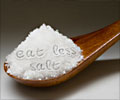Sodium nitrite which is used as a food preservative could become a treatment medicine for various diseases such as sickle cell anemia, heart attacks, and brain disorders. When oxygen level in blood comes down, the nitrite in the body gets converted to nitric oxide leading to dilation of the vessels leading to formation of more blood and more oxygen. Sodium nitrite may help to understand the mechanism of blood flow in the body and the mechanism of the body in protecting when the flow of blood is disrupted. Sodium nitrite helps in preservation of heart, lungs and brain tissues against cellular death when the oxygen in these tissues is depleted. Sodium nitrite interacts with hemoglobin in a way that it is released only where it is required.
Scientists at the National Institute of Health, NIH are studying the effect of sodium nitrite in diseases caused by low oxygen; they are recruiting human volunteers to test the effect of sodium nitrite in the treatment of sickle cell anemia, heart attacks, brain aneurysms and asthma.If it works, "this drug would be pennies to dollars per day," says Dr. Christian Hunter of California's Loma Linda University. By January, Hunter hopes to begin studies of nitrite treatment for babies with an often fatal disease called pulmonary hypertension. "It's so easy to use."
Gladwin and an NIH cardiologist, Dr. Richard Cannon III, discovered the beneficial effects of nitrite's accidentally when working with its related compound nitric oxide. Nitric oxide was known to improve blood flow by dilating blood vessels.
Blood flow increased remarkably when Gladwin and Cannon injected sodium nitrite into healthy volunteers, they found that tiny doses of sodium nitrite almost tripled blood flow and when people exercised after taking a dose of sodium nitrite the nitrite levels in the muscles increased. "This has led to an avalanche of work," says Gladwin, who this week hosts an NIH meeting where scientists will compare nitrite research. High dosage levels of sodium nitrite is used as an antidote for cyanide poisoning, but at high levels sodium nitrite can become toxic. A case of sodium nitrite poisoning was reported in 1944, in which 11 New York workers turned blue, and their blood was found struggling for oxygen, after they accidentally consumed sodium nitrite mistaking it for table salt.











